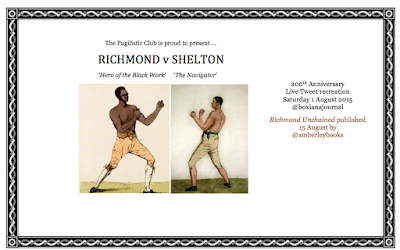This Saturday
marks the 200th anniversary of the Bill Richmond v Tom Shelton
bare-knuckle boxing contest. By way of a celebration, I will be tweeting
a live recreation of the fight, including many illustrations and
images, via my twitter page @boxianajournal
Richmond versus Shelton was a fascinating event from both a sporting and a sociocultural perspective. In purely pugilistic terms, the fight represented the perfect conflict between 'youth' and 'experience' that has become such a trope of sporting discourse - taking place as it did just two days before Richmond's 52nd birthday, while Shelton was a mere 27 years old. The contest would ultimately prove to be the final official contest of Richmond's stellar career, and the only time that he fought at the iconic venue of Moulsey Hurst in Surrey on the southern banks of the river Thames.
Significantly, the bout took place less than two months after Britain's triumph in the Battle of Waterloo. The militaristic context of this, and many other Georgian prize fights, enables us to understand that for many people bare-knuckle boxing was a natural expression and off-shoot of Britain's military might and prowess.
Indeed, throughout the early part of the 19th century, the exploits of the country's leading pugilists inculcated many of the general public with a feeling of self-confidence that the nation would ultimately repel the challenge of France and Napoleon. Such confidence had been legitimised by the sensational events of Waterloo - hence by August, when Richmond fought Shelton, there was a sense of widespread pride and joy among the Fancy. No wonder, then, that over 10,000 spectators gathered on Tuesday 1 August to watch the contest!
As you would expect, newspapers published on 1 August were heavily preoccupied with the political and military fall-out from Waterloo and Napoleon's surrender, and speculation concerning 'Boney''s ultimate fate was a running theme in many journals. As the extract below from The Times of 1 August shows, some believed (or perhaps hoped!) that the former French emperor might end up in the Tower of London!
How then, did Bill Richmond - a black prize fighter who began life as a slave in the United States - fit into the celebration of British military and physical might that the sport of pugilism so often symbolised?
It's a fascinating question, and one which is examined in depth in my upcoming book Richmond Unchained. As a black celebrity within white-dominated Georgian England, Richmond was certainly in an unusual position; the Slave Trade Act of 1807 may have abolished the slave trade, but slavery itself still existed throughout the British Empire, as made clear by this advertisement which appeared in The Times the same day that Richmond faced Shelton.
Despite the continuing spectre of slavery, Richmond had achieved such a position of respectability and fame within sporting circles that his ethnicity was not mentioned or referred to in disparaging terms in reports of the Shelton fight. For example, the Morning Post's 1 August preview of the fight referred to him as "the black" and a "first rater", in sharp contrast to earlier in his career when he had been routinely disparaged by newspapers as "Mungo" or "Blacky".
By this stage of his career, Richmond's talents and fame seemed to render his ethnicity unimportant to many spectators and observers - one of many amazing achievements within his remarkable life.
Richmond v Shelton is recreated this Saturday on www.twitter.com/boxianajournal
Richmond Unchained is published on 15 August
Richmond Unchained is published on 15 August




No comments:
Post a Comment